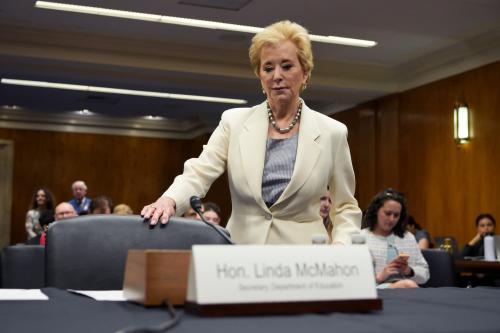This is a summary of an event held on October 14, 2025. You can watch the full video of the event here.
On October 14, 2025, the Center on Economic Security and Opportunity (CESO) hosted a panel discussion on reforms made to federal student loan programs in the One Big Beautiful Bill Act (OBBBA). The discussion focused on the implications of new loan limits in the Parent PLUS program and the elimination of the Grad PLUS program, which will reduce how much graduate students are able to borrow. The panel included Justin Draeger of the Strada Education Foundation, Jordan Matsudaira of American University, Sarah Turner of the University of Virginia, and was moderated by Sarah Reber, a senior fellow at CESO.
Opening the event, Jordan Matsudaira explained that federal student loans are necessary to facilitate productive investments in post-secondary education and described how loan limits can limit the exposure both borrowers and taxpayers face. He argued that the new lower loan limits for graduate students under OBBBA will be quite binding, with up to one third of graduate borrowers currently exceeding these limits. While restricting access to credit could lower costs, Matsudaira cautioned that it could also close off lucrative careers for lower-income students who lack the credit history or family support to finance their education without access to federal student loans.
Justin Draeger argued that loan limits are a necessary component to any federal student loan program. He referenced the finding of a Congressional Budget Office (CBO) report which estimated that graduate students were projected to account for about 80% of the value of loan forgiveness through income-driven repayment plans. He questioned if that is striking the right balance of subsidies for graduate and undergraduate education. Draeger also suggested the CBO finding created demand for changes to the student loan system. And as is often the case, absent a proactive and cohesive policy alternative from higher education institutions, lawmakers addressed these concerns with “blunt instruments” that can fall short of fully addressing the full range of very real affordability problems in graduate education.
Sarah Turner pointed to the possibility that the lower loan limits for graduate borrowers will have a disproportionate impact on lower-income students. She notes though that the cost of attendance varies considerably across programs, even in the same field, making it difficult to generalize about which types of programs and students will be most affected. Private institutions do tend to have higher tuition, she noted, so they will be more affected by the borrowing limits.
Turning to borrowing for undergraduate education, Turner explained the new limits in the Parent PLUS program, which allows parents to borrow for their children’s undergraduate education. She argued that the new limits are mis-targeted to address existing problems in the program. Higher-income families, who don’t typically struggle as much to repay, will find the limits to be the most binding. Meanwhile, lower-income families may still borrow more through the Parent PLUS Program than they can afford to repay, affecting their ability to retire and address other needs. Draeger suggested that more underwriting–not necessarily as it would be in the private sector, but stricter than current standards–might be necessary to address this problem. The panelists agreed that the new Parent PLUS loan limits do not address the underlying affordability problem many lower-income undergraduates face.
Matsudaira pointed to research that suggests the introduction of the Grad PLUS program contributed to higher tuition costs in the 2000’s. However, he argued that the context is much different now, so it is not clear that eliminating Grad PLUS will bring tuition down. Draeger added that undergraduate loan limits have been fixed for years, meaning the inflation-adjusted limit has declined, effectively reducing the level of support undergraduates receive.
Matsudaira pointed to a common theme in the discussion of both graduate and parent borrowing. The loan limits tend to restrict borrowing for many borrowers who will have high earnings in the future. Loan limits are not necessarily bad, according to Matsudaira, but they need to be right sized based on the education the borrower is pursuing. He has found loan limits, as currently designed, would have differential impacts on borrowers. He suggests setting limits that are “more varied with respect to the potential earnings of people within particular fields and programs” and complementing loan limits with other policies such as gainful employment regulations.
Reber and Turner concluded by distinguishing between students who need loans to make investments in education that pay off with higher earnings and the separate issue of socially valuable careers–like teaching and social work–that require significant educational investments but have modest earnings. A well-functioning student loan program can address the former but not the latter issue, which may require subsidies rather than loans.
The Brookings Institution is committed to quality, independence, and impact.
We are supported by a diverse array of funders. In line with our values and policies, each Brookings publication represents the sole views of its author(s).




Commentary
Student loan limits: Takeaways from a recent Brookings panel
October 29, 2025